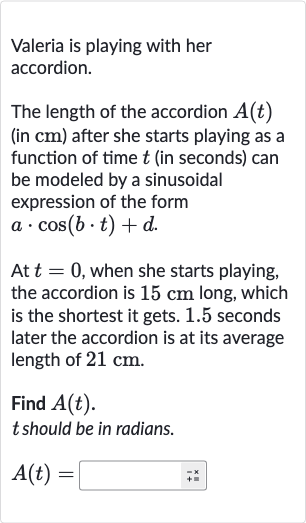AI tutor
Welcome to Bytelearn!
Let’s check out your problem:

Valeria is playing with her accordion.The length of the accordion (in ) after she starts playing as a function of time (in seconds) can be modeled by a sinusoidal expression of the form .At , when she starts playing, the accordion is long, which is the shortest it gets. . seconds later the accordion is at its average length of .Find . should be in radians.
Full solution
Q. Valeria is playing with her accordion.The length of the accordion (in ) after she starts playing as a function of time (in seconds) can be modeled by a sinusoidal expression of the form .At , when she starts playing, the accordion is long, which is the shortest it gets. . seconds later the accordion is at its average length of .Find . should be in radians.
- Determine Amplitude: Determine the amplitude of the sinusoidal function.Since the accordion starts at its shortest length of and goes to its average length of , the amplitude is the difference between the average length and the shortest length.
- Determine Vertical Shift: Determine the vertical shift of the sinusoidal function.The vertical shift is the average length of the accordion, which is given as cm. cm
- Determine Angular Frequency: Determine the angular frequency of the sinusoidal function.We know that the accordion reaches its average length after seconds, which corresponds to half of the period of the sinusoidal function. Therefore, the period is seconds = seconds.The angular frequency is related to the period by the formula .
- Write Sinusoidal Function: Write the sinusoidal function . Since the accordion starts at its shortest length, we know that the cosine function starts at its minimum value. Therefore, we need to reflect the cosine function vertically to match the behavior of the accordion's length. This means we will use a negative amplitude in our function. Substitute the values of , , and into the equation.
More problems from Write exponential functions: word problems
QuestionGet tutor help
QuestionGet tutor help
QuestionGet tutor help
QuestionGet tutor help
QuestionGet tutor help
QuestionGet tutor help
QuestionGet tutor help
QuestionGet tutor help
